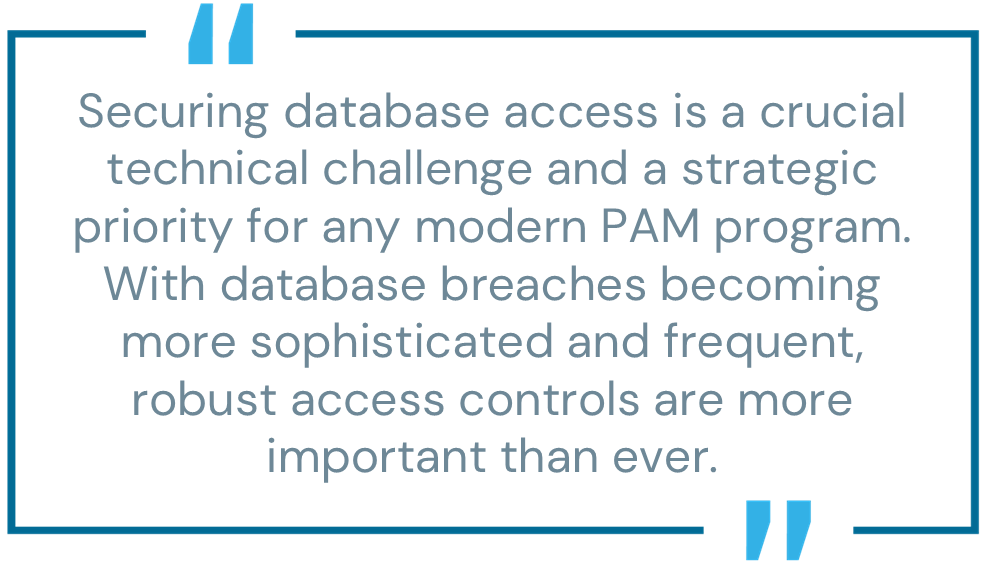
Securing database access has become a critical concern for organizations globally. Your organization’s data is its most valuable asset, encompassing everything about your business, partners, customers and employees. A data breach could jeopardize your entire operation.
Organizations provision powerful access privileges to public cloud roles that enable the administration of elastic cloud workloads, such as virtual machines (VMs) and databases. Moving toward the assumption of IAM roles and away from dedicated privileged accounts reflects a shift in security practices aimed at minimizing risk, increasing flexibility and enhancing control over access to sensitive systems and data. IAM roles offer temporary, scope-limited access that better fits modern organizations’ dynamic and scalable needs, particularly in cloud and hybrid environments.
The increasing frequency of data breaches, such as the recent Snowflake customer attacks, underscores both the vulnerabilities inherent in privileged access to databases and the importance of applying stringent controls to securing this valuable asset.

Targeted Snowflake Customer Attacks: Understanding the Attack Chain
The Snowflake breach is a good example of the risks of inadequate privilege controls. In this case, the attackers identified credentials in ‘credential dumps’ comprising stolen credentials lists, like those from Snowflake, and easily exploited them. The incident affected organizations using Snowflake services to store their data in Snowflake’s cloud-based database.
As widely reported, hundreds of Snowflake customers were affected by the breach – the full extent of the damage still isn’t publicly known. The breach highlights the importance of robust authentication mechanisms such as multi-factor authentication (MFA), session isolation and credential rotation – and the consequences of overlooking these fundamental security protocols.
Secure Access: A Top Priority for Organizations
As the use of cloud-based databases grows and the number and complexity of breaches rise, organizations increasingly prioritize securing access to databases as part of their PAM modernization programs. Data breaches jeopardize sensitive information, damage reputation, incur substantial financial costs and lead to failures in satisfying audit and compliance demands.
Implementing stringent access controls and reducing access rights to databases to the bare minimum is essential for mitigating these risks and safeguarding organizational assets and data. Organizations typically look for easy-to-onboard and easy-to-use solutions to secure access to databases, prioritizing user experience alongside the security benefits of their chosen solution. Requirements include high availability, non-intrusive, lightweight deployments, process automation and – equally necessary – detailed audit and SOC view of sessions.
Enhancing Accessibility: Making it Easier, Friendlier and Safer
Balancing security with user experience is crucial in optimizing privileged access. The ideal would be to provide users with a native user experience that increases security without impacting operational efficiencies and offers fast ROI. Implementing intuitive authentication methods, multifactor authentication and role-based access controls (RBAC) can streamline access workflows without compromising security. User training and awareness programs also play a vital role in promoting safe access practices.
Ensuring authorized personnel can perform their duties without interruptions is pivotal in any environment. Securing access to databases with zero standing privileges (ZSP) addresses this challenge by dynamically granting access based on contextual factors such as user roles, device posture and behavioral analytics. This means no user has any entitlements by default, mitigating the risk of an attacker compromising their access.
Instead, when a user needs access to a cloud-based database, it’s best to provide a time-bound role for the session. This role will only have the exact entitlements required for the specific task. Every privileged session should be isolated, and the role and all associated entitlements should be removed when the session ends. This approach minimizes the attack surface and enables efficient operations and a positive user experience.
Out-of-the-box (OOTB) integrations are a great addition to any security offering as they significantly help enable privileged access management (PAM) to databases and, if provided natively, even better. These integrations reduce the risk of misconfigurations and errors in manual processes and accelerate deployment, as in most cases, there’s no need for custom coding. OOTB integrations should align with common industry standards, helping to satisfy audit and compliance demands and applying the same privilege controls to databases as in other environments and target systems in your organization.
Securing Database Access: A Strategic Priority
Securing database access is a crucial technical challenge and a strategic priority for any modern PAM program. With database breaches becoming more sophisticated and frequent, robust access controls are more important than ever. Implementing advanced security measures like ZSP, MFA and RBAC can help minimize risks while keeping things running smoothly. Focusing on lightweight, user-friendly solutions and ongoing training can help to ensure that security protocols are effective and easy to use in daily operations.
By proactively prioritizing these measures, organizations can secure, control and monitor database access without sacrificing efficiency, user experience and strengthen customer trust.
Lilach Faerman Koren is a senior product marketing manager at CyberArk.





















